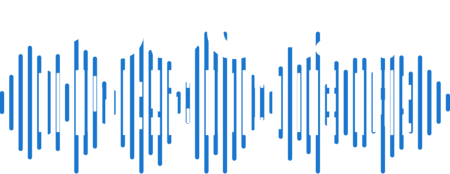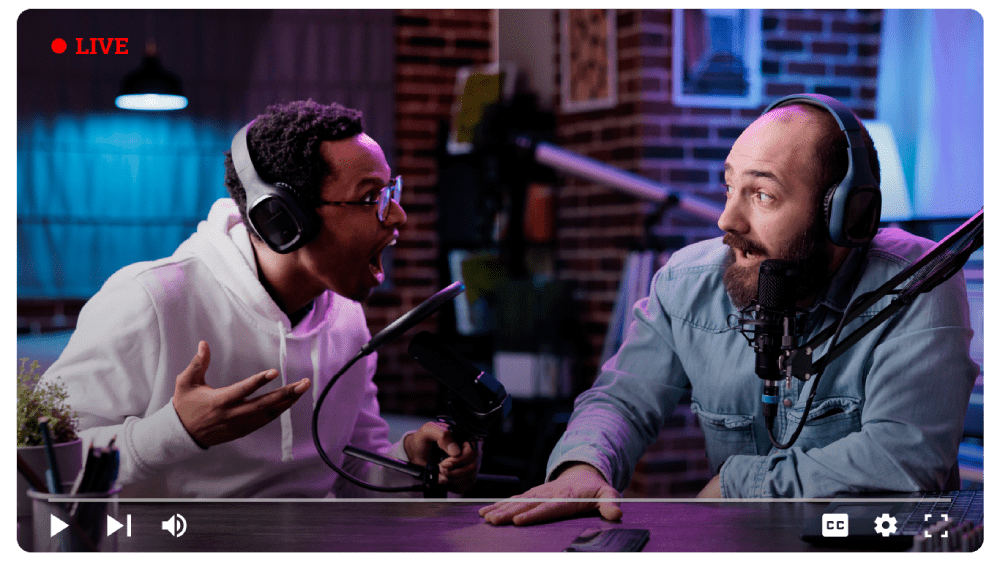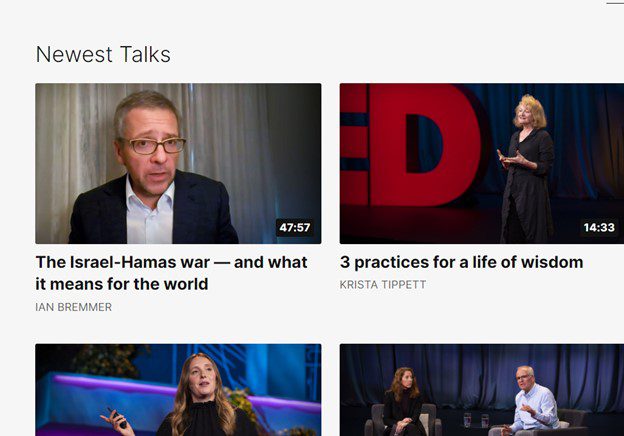Where Should You Go to Host a Video Podcast?
With advancements in digital media and technology, the possible apprehension and intimidation of video podcasting is giving way to thoughts of, “Hey, I can do this!”
Video podcasting has become increasingly popular among content creators and viewers in recent years. With the growing podcast industry and the rising demand for engaging visual content, numerous platforms have emerged to cater to these needs. One platform that has supported video podcasters all along is Blubrry Podcasting. Widely recognized as a leader in the industry, Blubrry is a favorite of podcasters for offering a simple solution for all their audio and video podcasting needs.
The most popular podcast platforms, such as Blubrry, provide users easy-to-use tools to create, publish, distribute and monetize their podcasts. These platforms offer seamless integration with podcast directories that allow video podcasts. This ensures the content reaches a broad audience while maintaining the highest quality audio and video standards. And, as in Blubrry’s case, they often include advanced analytics features that allow creators to gain valuable insights into listener demographics and preferences.
It is important to understand the distinction between video podcasts and YouTube videos. While both involve visual elements accompanying audio content, a video podcast requires an RSS feed that distributes episodes directly to subscribers’ devices or applications.
That said, YouTube is an incredible asset to podcasters! It’s one more step in your process, but uploading your video podcast to YouTube or creating your podcast from your YouTube video is of great value to draw attention to your show. YouTube simply lacks the RSS capabilities to distribute the actual content to your audiences.
With this in mind, it is clear that choosing the best video podcast platform is critical for creators looking to maximize their reach and impact. Considering its extensive suite of tools and services tailored for this purpose, Blubrry remains among the top contenders.
A Couple Examples of Successful Video Podcasts
When embarking on the journey of creating a video podcast, one might be interested in exploring some examples that exemplify excellence within this medium. Among some of the best video podcast examples are TED Talks Daily Video Podcast – featuring thought-provoking presentations by today’s leading thinkers – and Trash Taste Podcast – showcasing influential personalities from diverse fields engaged in long-form conversations. These examples provide insights into how an engaging narrative can be conveyed through visual storytelling techniques.
To record a high-quality video podcast efficiently, selecting the best platform is of utmost importance. Blubrry stands out by offering a comprehensive solution that caters to all aspects of video podcast production, from recording and editing to distribution and analytics. Its seamless integration with popular podcast directories ensures that your content reaches the intended audience without any hassle.
Discussing some of the top video podcast platforms can further clarify why Blubrry has become an industry leader. These platforms offer tools for creating and publishing podcasts and advanced features such as detailed analytics, monetization options, custom branding capabilities, and more. By constantly evolving its offerings to meet the ever-changing demands of content creators, Blubrry remains an ideal choice for starting or expanding a video podcast series.
What Exactly is a Video Podcast?
Understanding the definition of a video podcast is crucial in determining how it differs from other forms of online content. Essentially, a video podcast is a series of episodes delivered through an RSS feed that includes both audio and visual elements. Subscribers receive these episodes directly via their preferred devices or applications – allowing them to view this content at their convenience. This sets video podcasts apart from YouTube videos, which are not distributed through an RSS feed and thus lack one of the vital components necessary for them to be considered genuine podcasts.
Selecting the best video podcast platform is essential for creators looking to produce engaging visual content that resonates with their audience while maximizing their reach and impact within this rapidly growing industry. With its extensive suite of tools and services tailored explicitly for this purpose – including seamless integration with various directories, advanced analytics features, monetization options, and more – Blubrry continues to hold its position as a trusted leader in the field.
Should You Be a Video Podcaster?
Sure, the concept of video podcasting sounds super fun, and there are a lot of good reasons to start or transition your show so your message can be seen as well as heard. But there are some downsides as well. Read over these as you weigh your decision to invest your time, energy and money on video podcasting.
Check out this how-to page about video podcasting in our Podcast Manual.
Pros of Creating a Video Podcast:
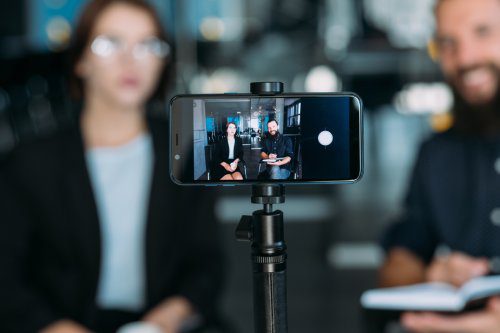
- Visual Engagement: Video podcasts allow you to connect with your audience on a more personal level by incorporating facial expressions, body language, and visual elements, enhancing viewer engagement.
- Diversified Content: Video podcasts provide an opportunity to diversify your content by incorporating visuals, graphics, slideshows, and on-screen demonstrations, making it easier to convey complex ideas or showcase products/services.
- Branding Opportunities: Video podcasts offer branding possibilities through customizable video overlays, logos, and backgrounds, helping you establish a unique and recognizable visual identity.
- Wider Reach: Video content is widely consumed on platforms like YouTube and social media, potentially expanding your podcast’s reach to a broader audience beyond traditional audio podcast platforms.
- Monetization Potential: Video podcasts can be monetized through ads, sponsorships, or premium content, potentially generating more revenue compared to audio-only podcasts.
- Enhanced Viewer Retention: Visual content can help capture and retain viewer attention, reducing the likelihood of distractions or multitasking while consuming your podcast.
Cons of Creating a Video Podcast:
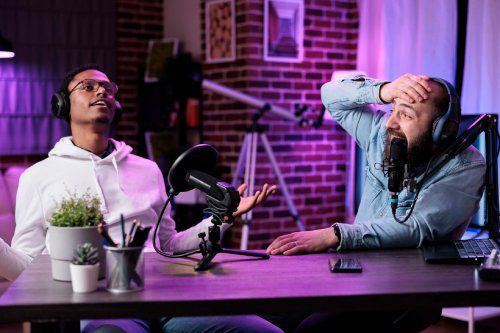
- Higher Production Costs: Video podcasts typically require more equipment, editing, and post-production work, leading to higher production costs compared to audio-only podcasts.
- Increased Time Investment: Video production takes more time and effort, from setting up lighting and camera angles to editing and rendering, which may slow down your content production schedule.
- Accessibility Challenges: Video content may not be accessible to all audiences, including those with visual impairments or limited bandwidth, potentially limiting your podcast’s inclusivity.
- Technical Challenges: Dealing with technical issues such as video and audio synchronization problems, software glitches, or file compatibility can be more complex in a video podcast.
- Visual Distractions: The presence of visuals can be distracting for some viewers, potentially reducing the focus on the podcast’s core message or content.
- Hosting and Distribution: Video files are larger than audio files, which can lead to challenges in hosting and distributing your podcast, including increased storage and bandwidth requirements.
Here is a page in the Blubrry Podcast Manual that can also help you decide, “Audio or Video?”
What Will You Need – and Need to Decide Upon – to Produce Your Video Podcast
Before producing a video podcast, podcasters should consider several important factors to ensure their content is engaging, appealing and well-prepared. Here are a whole bunch key considerations – and links so you can read more on how Blubrry can support these factors:
Content Planning:
- Define your podcast’s niche, topics, and target audience.
- Outline the structure and format of your episodes.
- Plan your episode content and script to ensure a coherent and engaging narrative.
Visual Elements:
- Incorporate images, graphics, and visual aids to enhance your podcast’s storytelling.
- Use B-roll footage (secondary footage) to add context, variety, and visual interest.
- Consider using animations, charts, and diagrams for explanatory purposes.
Equipment and Setup:
- Invest in quality audio and video equipment, including microphones, cameras, and lighting.
- Choose a suitable filming location with good lighting and minimal background noise.
- Use a tripod or stabilizer to ensure stable and professional-looking shots.
Visual Consistency:
- Establish a consistent visual style for your podcast, including colors, fonts, and graphics.
- Create an appealing opening and closing animation or sequence to reinforce your brand.
Script and Storyboarding:
- Write a clear and engaging script that guides your narrative.
- Storyboard your video to plan camera angles, shots, and transitions.
Live Action and Presenters:
- If featuring live action or presenters, ensure they are well-prepared, articulate, and comfortable on camera.
- Consider using a teleprompter or cue cards to assist with delivery.
Settings and Background:
- Choose a background that is relevant to your podcast’s topic and visually appealing.
- Keep the background uncluttered and free from distractions.
- Use depth of field (e.g., blurred backgrounds) to draw focus to the speaker or subject.
Lighting:
- Invest in proper lighting equipment to ensure your subjects are well-lit and the video quality is high.
- Consider natural light sources or softbox lights for a flattering and even illumination.
Editing and Post-Production:
- Edit your video for pacing, removing mistakes, and adding visual enhancements.
- Incorporate appropriate transitions, text overlays, and music to enhance the viewing experience.
- Check out Pro Production with Blubrry to learn how to expedite this process.
Accessibility:
- Add closed captions or subtitles to make your content accessible to a wider audience.
- Ensure your video player is compatible with screen readers for visually impaired viewers.
Test and Feedback:
- Before releasing episodes, test your equipment and recording setup to address technical issues.
- Seek feedback from peers or a test audience to refine your video podcast’s quality and content.
Promotion and Distribution:
- Plan how and where you will distribute your video podcast, whether on YouTube, social media, or a dedicated website.
- Promote your episodes through effective marketing strategies to reach your target audience.
By considering these methods and factors, video podcasters can create compelling, visually appealing content that engages viewers and helps their podcast stand out in a competitive landscape.
As more people discover the benefits of subscribing to video podcasts – including on-the-go access to thought-provoking discussions and captivating storytelling techniques – we can expect these platforms’ popularity to continue rising exponentially. Employing platforms like Blubrry to create, distribute and monetize high-quality video podcasts will remain a top priority for content creators striving to make their mark.
For more tips and information on creating and promoting your podcasts, visit our Podcast Manual.





